Want better results from your email marketing?
Then you need to start thinking about automation.
In this article, I’ll walk you what email marketing automation is and how you can use it to get the best results possible.
What is Email Marketing Automation?
Like it sounds, email marketing automation is the process of sending emails to your customers and leads automatically.
Unlike one-off campaigns or newsletters you create and send in real-time, email automation lets you set up a workflow once and automatically send to a user based on an action or trigger you define.
And chances are, you’ve already seen them in action.
Ever received a welcome email after signing up for a newsletter or downloading a PDF? How about an email wishing you a happy birthday?
Both of those are part of automated workflows.
And they don’t stop there. Often, email automation workflows can include an entire series of emails as part of a drip campaign.
Think about it: entire drip campaigns set up once and ready to go when triggered and on schedule.
Clearly, automating your email marketing is a time saver.
But that’s not even the biggest benefit.
Automated emails are timely and highly personalized. They’re designed to deliver the right content at exactly the right time, and allow you to form deeper, more personalized relationships with your prospects because of it.
Not only that, but well-timed and relevant emails help you nurture a lead through the sales cycle.
Above all, automated emails simply produce better results from customers and prospects.
Automated emails get 119% higher click-through rates (CTRs) than other emails, and emails personalized through automation generate up to 6x higher revenue than non-personalized emails.
Email Automation Software: Which is Right For You?
As you’ve probably guessed, automation doesn’t happen on its own.
It happens through email automation software. Different software will come with different capabilities, but generally speaking, they’ll accomplish the same goals.
Good news is if you’ve been doing any email marketing at all your current software can likely help you automate your campaigns.
Take MailChimp. It’s a huge player when it comes to email marketing (and one of my favorites for getting started).
With MailChimp, you can set up drip emails that deploy when based on website activity, abandoned carts, periods of inactivity, etc.
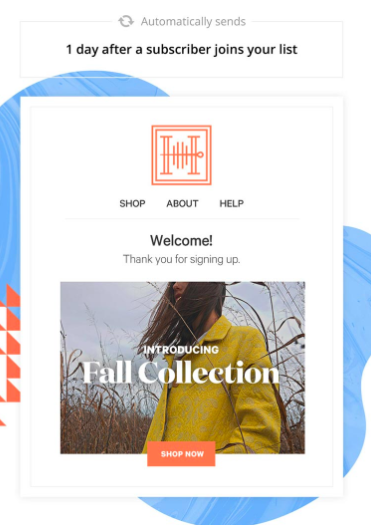
Email marketing automation: software like MailChimp typically comes with preset automations
You can connect it with a software like OptinMonster to drill down even further and send emails based on what kinds of topics a subscriber opted in for.
But MailChimp certainly isn’t the only player in the game. ActiveCampaign, Drip, SendLoop, Campaign Monitor, etc. all come with automation capabilities.
The problem? Almost any software you select will come with different tiers.
Many offer a free plan that can be tempting to go for, but as a general rule: the lower the price tag, the fewer the capabilities.
Here’s a rundown to help get you started. (Disclaimer: every software is different, so make sure you do some digging on your own before selecting any plans).
- Freemium models:
- Best for very small or local businesses
- Best if your email lists have fewer than 500 subscribers
- Mid-tier models:
- Best for small/medium sized businesses
- Best for businesses with an interest in expanding their email lists
- Enterprise level models:
- Best for large, established businesses
- Best for businesses with hundreds (even thousands) of audience segments
- Best for businesses looking for the highest customization capabilities
Email Marketing Automation: Set Your Trigger
We know that automated emails are sent based on customer triggers.
It makes sense then that one of the first steps in setting up a campaign is defining what those triggers will be.
A lot of software will come with preset automations with built-in triggers, though those more advanced usually have the option to set custom triggers as well.
But for those new to the game, where do you start?
Your best bet is to choose your highest value triggers.
MailChimp explains that those generally come from frequent triggers to high motivated leas.
For example, a birthday email is sent only once a year and doesn’t prompt much action, so it would be considered a low-quality trigger.
On the other hand, abandoned carts happen quite frequently. Anyone who made it that far in the buying process more motivated to take action, making it a high-quality trigger.
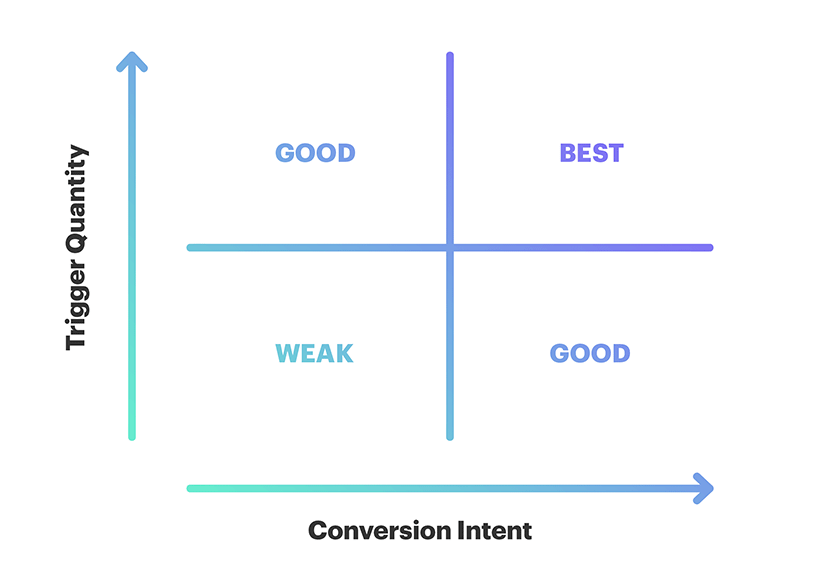
Email marketing automation, courtesy of MailChimp
Beyond that, the triggers you choose should match the goals your business is trying to accomplish.
So, if you run an e-commerce business and your goal is to increase sales, your triggers would be:
- Clicking away from check out – send abandoned cart emails
- Purchase and payment submitted – purchase confirmation email, shipping confirmation, tracking information, etc.
- Purchase received – follow-up emails with related products, surveys, etc.
Or, If your goal was to re-engage past customers or lapsed leads, triggers could be:
- 30 days without a purchase – send a “we miss you” email with a coupon
- 30 days without starting free trial – send another email on how to get started
Your goal may be to simply keep new or existing leads engaged:
- A day after sign up – send a welcome email
- After a third purchase – send an exclusive VIP email
- On a customer’s birthday – send a Happy Birthday email
When in doubt (and depending on your business), setting abandoned cart, welcome emails, and quote requests or form fills automations into action are good places to start.
Email Marketing Automation: Determine Your Drip or Workflow
Emails you schedule to send out in drip form can be a great way to stay engaged with customers and earn new leads.
These come as follow-ups to your initial triggered email, and almost every scenario can benefit from sending a series of emails, rather than a one-off (with the obvious exceptions of birthday or anniversary emails).

Email marketing automation: drip campaigns
In fact, drip emails generate 3x the click-through rate of a typical marketing email.
Not only that, but drip open rates are about 80% higher than single sends, and companies that excel at drips generate 80% more emails 33% lower costs.
Drips, or workflows, are set up similarly to your trigger email and scheduled depending on the frequency you want to deploy them.
If you’re new to drip emails, I recommending starting your campaign with a series of three emails. From there, you can adjust the frequency based on the performance.
Here’s the thing to remember when setting up automated workflows: you need to account for all scenarios.
So, say you send an email with a free download. If the recipient clicks and downloads, you need a follow-up to their action.
But if they don’t click (or even open) your email, you’ll need another email ready to go to help re-engage the user.
Here’s an example scenario:
- You send them a whitepaper download after your welcome email
- They open the email – send them an ebook download or related articles from your website
- They don’t open the email – send a video to encourage more interaction
And of course, the drip would continue from there based on the recipient’s actions.
It can get complicated fast, which is why it’s important to have a game plan and focused strategy on how to engage your users.
Email Marketing Automation Workflow Examples
While the workflows you ultimately choose will depend on your overall goals, let’s go over a few examples to help you started.
-
The Welcome Email Series
Trigger: Form Submission or Download on Site
When a visitor to your site becomes a new customer or contact, give them a proper welcome with an automated email series.
These emails are designed to welcome the new member, provide any training needed, set expectations and keep customers engaged after they buy or convert.
Email 1: A straightforward welcome. Let them know you’re glad to have them on board and that they’ve made the right decision. Deliver on any promises you may have made pre-sign up (special offers, coupons, etc.)
Email 2: Provide some added value. Be proactive and address a pain point your target audience typically faces with a quick tip or strategy. Or, if they’ve signed up for a trial of your product, send some tips for getting started.
Email 3: Send useful resources. Point them to relevant articles on your website or downloads that might prove useful, based on what they’ve signed up for.
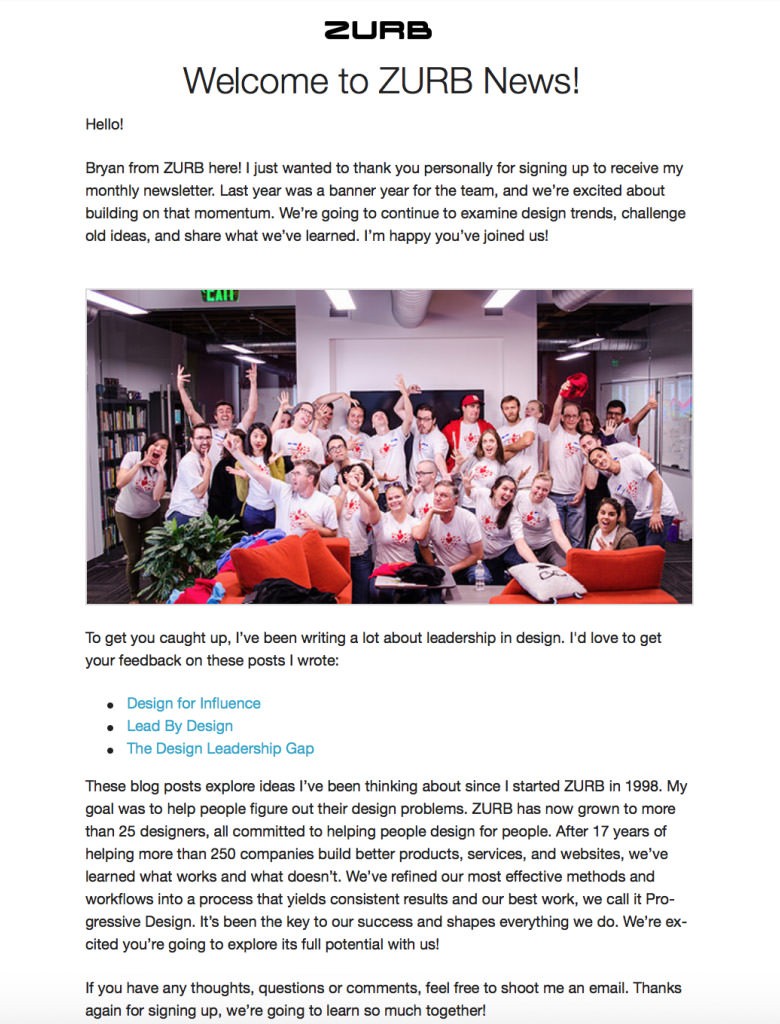
Email marketing automation: welcome email example from Zurb News
-
Engaged Users/Lead Nurturing Workflow
Trigger: Email or Website Clicks and Visits
This one plays off of your welcome email series.
It stands to reason that some of your recipients will interact more with your emails than others, and those that continually open your emails and click through to site or landing page.
Those that do have a good probability of becoming qualified leads – if nurtured correctly.
Email 1: Send a whitepaper download or intro to a long-form blog post. This should expand on the ways your company or service can help them.
Email 2: Send them pages you’ve identified as top-converting on your site. These could be case studies or past success stories (and highlight any similarities they may share with your current leads)
Email 3: Send them a free trial offer or product demonstration. Or, if you’re more on the service side, send a them a video from a thought leader in your company highlighting the value of your service.
-
Re-engagement Workflow
Trigger: Past Purchase, 30 Days Inactive
The road doesn’t end when a lead becomes a customer.
And if it does, it’s time to point them in a new direction.
After a purchase is made, put the effort into reaching out re-engaging that customer.
While it’s generally accepted knowledge that it’s cheaper to keep a customer than a acquire a new one, stats also say that 60-80% of customers who describe themselves as satisfied don’t go back for repeat purchases.
A lot of that is due to a loss of contact and engagement (and to be clear, a re-engagement or customer satisfaction are whole workflows unto themselves).
This one can is also effective for users who either signed up for a demo and never used it or visited a product or pricing page without purchasing.
Email 1: Go for the ask. Tell them you noticed they stopped by (or stopped coming by), and ask if they have any questions for you.
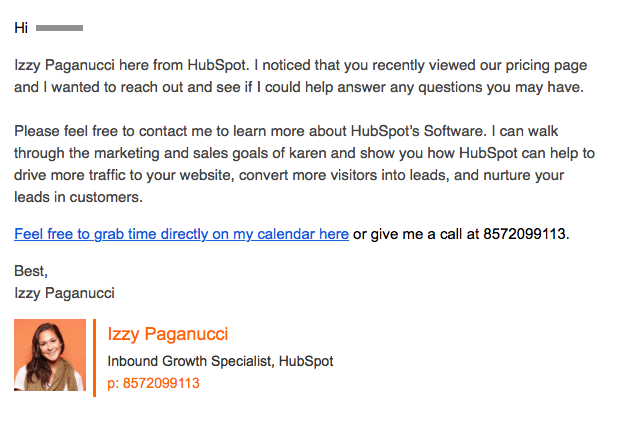
Email marketing automation: re-engagement email example from Hubspot
Email 2: The helpeful resource. If they made a purchase, ask how it’s going. If they’ve been unresponsive, try re-engaging with a new video highlighting a few awesome features.
Email 3: Last chance. Ask if they’d like to unsubscribe from your emails, and tell them you hope they’ll be back. Three is usually the cut-off when it comes to re-engagement; too may emails and you’ll quickly become a nuisance.
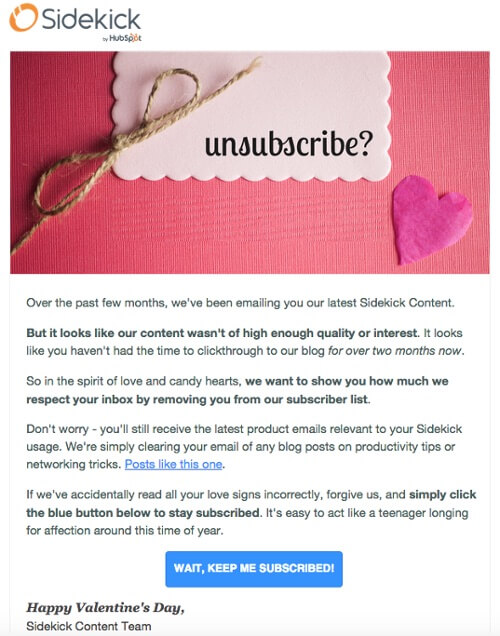
Email marketing automation: re-engagement email example from Sidekick
Email Marketing Automation: Track Your Results
The last step in the process is continuously monitoring your results and adjusting accordingly.
Email marketing automation comes with a lot of moving objects – list segmentation, send frequency, timing – along with all the email testing staples like headline, creative, send names, etc.
For best results, use A/B tests to figure out which version of your emails returns the best results.
Most email software will give you access to data like opens, clicks, etc. You should pay special attention to:
- Delivery rate
- View rate
- Open rate
- Click-through rate
- Conversion rate
For more on which email metrics you should be measuring and how to get better results, read my full article here.
If your software allows it, you should also integrate with Google Analytics so you can keep tabs on customers and revenue growth, and how much is coming from your email marketing.
Keep an active eye on all of your workflows.
For example, if you find that a large percentage of customers are opening your first welcome email, but decreasing as you send more, you may need to cut down the number of emails in your series or take a hard look at the content you’re offering.
And as always, this is an ongoing process.
Check on your analytics often and continue to make tweaks to your workflows and content for the best results.
Essentials of Email Marketing Automation
To really take your email automation, keep the following tips in mind:
- Add personalization. A lot of this will be done based website or buying behavior, but little touches like personalized to and from names still go a long way.
- Really understand your buyer’s journey before you begin. What kind of questions do your customers typically ask your sales team? What’s the biggest barrier to entry? What features are they most satisfied with? These are the questions and benefits you’ll want to answer and highlight in your drip emails.
- Keep your lists clean. You don’t want to have one person in too many of your email segments (unless indicated by interest); that person(s) could easily suffer from email fatigue
- Have a lead scoring system in place to help determine when a lead is ready to passed off to your sales team.
- As always, pay special attention to the content of each email. Make sure what you say aligns with the action you want the user to take, and include strong CTAs and personalized stories.
Wrapping Up Email Marketing Automation
Email remains a constant in the marketing world.
And with the new software and technology available, it’s easier than ever to stay engaged with your audience.
Remember, the email triggers and workflows you determine should always align with your overall goals.
And when in doubt, test for success.
